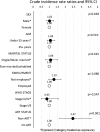Noncommunicable disease burden among HIV patients in care: a national retrospective longitudinal analysis of HIV-treatment outcomes in Kenya, 2003-2013
- PMID: 30943975
- PMCID: PMC6448214
- DOI: 10.1186/s12889-019-6716-2
Noncommunicable disease burden among HIV patients in care: a national retrospective longitudinal analysis of HIV-treatment outcomes in Kenya, 2003-2013
Abstract
Background: Over the last decade, the Kenyan HIV treatment program has grown exponentially, with improved survival among people living with HIV (PLHIV). In the same period, noncommunicable diseases (NCDs) have become a leading contributor to disease burden. We sought to characterize the burden of four major NCDs (cardiovascular diseases, cancer, chronic respiratory diseases and diabetes mellitus) among adult PLHIV in Kenya.
Methods: We conducted a nationally representative retrospective medical chart review of HIV-infected adults aged ≥15 years enrolled in HIV care in Kenya from October 1, 2003 through September 30, 2013. We estimated proportions of four NCD categories among PLHIV at enrollment into HIV care, and during subsequent HIV care visits. We compared proportions and assessed distributions of co-morbidities using the Chi-Square test. We calculated NCD incidence rates and their confidence intervals in assessing cofactors for developing NCDs.
Results: We analyzed 3170 records of HIV-infected patients; 2115 (66.3%) were from women. Slightly over half (51.1%) of patient records were from PLHIVs aged above 35 years. Close to two-thirds (63.9%) of PLHIVs were on ART. Proportion of any documented NCD among PLHIV was 11.5% (95% confidence interval [CI] 9.3, 14.1), with elevated blood pressure as the most common NCD 343 (87.5%) among PLHIV with a diagnosed NCD. Despite this observation, only 17 (4.9%) patients had a corresponding documented diagnosis of hypertension in their medical record. Overall NCD incidence rates for men and women were (42.3 per 1000 person years [95% CI 35.8, 50.1] and 31.6 [95% CI 27.7, 36.1], respectively. Compared to women, the incidence rate ratio for men developing an NCD was 1.3 [95% CI 1.1, 1.7], p = 0.0082). No differences in NCD incidence rates were seen by marital or employment status. At one year of follow up 43.8% of PLHIV not on ART had been diagnosed with an NCD compared to 3.7% of patients on ART; at five years the proportions with a diagnosed NCD were 88.8 and 39.2% (p < 0.001), respectively. CONCLUSIONS: PLHIV in Kenya have a high prevalence of NCD diagnoses. In the absence of systematic, effective screening, NCD burden is likely underestimated in this population. Systematic screening and treatment for NCDs using standard guidelines should be integrated into HIV care and treatment programs in sub-Saharan Africa.
Keywords: Antiretroviral therapy (ART); Comorbidities; HIV; Kenya; Noncommunicable diseases.
Conflict of interest statement
Ethics approval and consent to participate
This study was approved by the Kenya Medical Research Institute’s Scientific and Ethics Review Unit, the Kenyatta National Hospital - University of Nairobi Ethics Review Committee as part of a nested study, and the Committee on Human Research of the University of California, San Francisco. This study was reviewed according to the Centers for Disease Control and Prevention (CDC) human research protection procedures and was determined to be and approved as research, but CDC was not engaged. As this research was retrospective, consent from study participants was not required.
Consent for publication
Not applicable.
Competing interests
The authors declare that they have no competing interests.
Publisher’s Note
Springer Nature remains neutral with regard to jurisdictional claims in published maps and institutional affiliations.
Figures



References
-
- WHO. Consolidated guidelines on the use of antiretroviral drugs for treating and preventing HIV infection Recommendations for a public health approach - Second edition. 2016. - PubMed
-
- WHO. Global Health Observatory Data. NCD mortality and morbidity. 2018 [Available from: http://www.who.int/gho/ncd/mortality_morbidity/en/.
-
- WHO. Global Action Plan for the Prevention and Control of Noncommunicable Diseases 2013-2020. 2013.
-
- Levitt NS, Steyn K, Dave J, Bradshaw D. Chronic noncommunicable diseases and HIV-AIDS on a collision course: relevance for health care delivery, particularly in low-resource settings - insights from South Africa. Am J Clin Nutr. 2011;94(6):1690S–1696S. doi: 10.3945/ajcn.111.019075. - DOI - PMC - PubMed
MeSH terms
Grants and funding
LinkOut - more resources
Full Text Sources
Medical

